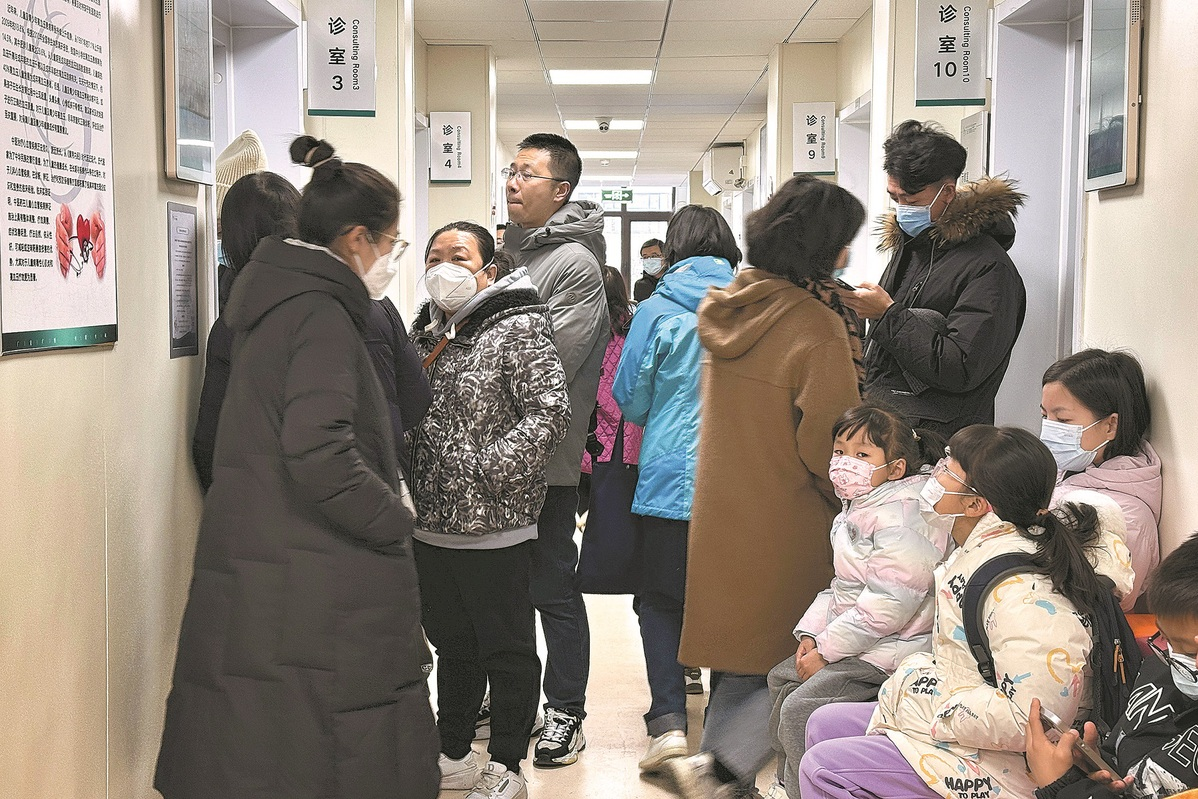Children and parents wait in the pediatrics department at Guang'anmen Hospital in Beijing on Sunday. The capital city has seen a surge in the number of patients with respiratory diseases recently. [Photo by Du Lianyi/China Daily]
China's health authorities advised medical institutes to implement hierarchical medical diagnosis mechanisms to relieve medical pressure in major hospitals amidst a spike in respiratory diseases and pneumonia across the country, especially among children.
The National Health Commission (NHC) has been monitoring the diagnosis among vulnerable children during the high incidence of infectious diseases, for which, the NHC has guided local medical institutes to allocate resources properly and adopt a hierarchical medical diagnosis mechanism, an official from the NHC said during an interview with the Xinhua News Agency on Thursday.
The official advised that minors who have relatively mild symptoms should see doctors at local clinics or the pediatric department of general hospitals to avoid dense gatherings and long wait times at major hospitals.
Mycoplasma infection, influenza and adenovirus infection are among the common respiratory diseases currently prevalent in China. Recently, the number of patients infected with mycoplasma has been declining, but other respiratory viral infections such as influenza are on the rise, media reported, citing respiratory experts.
In the week of November 13-19, the positive rate of influenza virus detection continued to rise in the southern and northern provinces, with the A (H3N2) subtype predominating, followed by B (Victoria), according to the newest weekly report on Thursday from China's National Influenza Center.
"I brought my kid to Beijing Children's Hospital a few days ago. It was fully packed. There were 300 people in front of us waiting. We waited four hours until afternoon to see a doctor," Liu, a mother of a 4-year-old, told the Global Times.
The Liulitun Community Health Center in Beijing's Chaoyang district has brought in two general practitioners and two nurses from a pediatric hospital to increase their admission capacity and better cope with rising cases of mycoplasma infection. Roughly 100 children have been visiting the center every day recently.
The center told the Global Times that it has also set up a specific observation room for children, stocked up on medicine and increased examination categories to deal with the spike in cases.
The situation in Shanghai is similar. The Global Times learned from one hospital insider that major hospitals in Shanghai have been increasing pre-examination tests and medical scheduling, as well as enhancing internet-based outpatient services as part of their efforts to alleviate the pressure at hospitals and reduce wait times.
But the insider said that the number of patients at the fever outpatient and emergency department of major pediatric hospitals in Shanghai has started to decline after hitting a peak. Taking Shanghai Children's Medical Center as an example, compared with the peak in early November, the number of patients in both fever outpatient departments and emergency rooms has decreased by 40 percent, the insider said.
Wu Yufen, a deputy director of the Outpatient and Emergency Department at Shanghai Children's Medical Center, told the Global Times that starting from October, the detection rate of RNA positive for mycoplasma pneumoniae at her hospital has increased from around 20 percent to 50 percent. Since mid-November, there has been a downward trend in mycoplasma pneumoniae infection, and currently, the positive RNA rate is around 30 percent, Wu said.
Concerning mycoplasma pneumonia, Tong Zhaohui, director of the Beijing Institute of Respiratory Medicine, said that it is a frequently seen respiratory illness which is prevalent in northern China during winter and autumn. Compared with previous years, this year has seen more infections among children under the age of 3 years old, but the state of their illness has no obvious signs of worsening, Tong noted.
The global monitoring of mycoplasma infection rate has been at a low level in the past three years. Combined with mycoplasma pneumonia, it has its own epidemic period, every 3-7 years a cyclical epidemic, which explains the prevalence of mycoplasma pneumonia among children this year, Tong noted.
Respiratory diseases among children in China have caught the attention of the World Health Organization, which on Wednesday requested China provide more detailed information on the increase of respiratory illnesses and reported clusters of pneumonia in children.
After three years of fighting against COVID-19, China's surveillance and monitoring for the prevalence of epidemics and general diseases has become more accurate and timely, Wang Guangfa, a respiratory expert from Peking University First Hospital, told the Global Times. "We shouldn't cast doubt on China's capability to monitor epidemic trends or respiratory diseases. More science studies will be needed to judge if there are any unknown reasons for these respiratory diseases."
The prevalence of respiratory illnesses this winter seems more noticeable than previous years, one of the key reasons being the rise of an "immunity gap" resulting from decreased antibodies against these pathogens among the general public due to the protective precautions taken in the past three years, Wang explained.
Given the fact that the incidence of influenza is on the rise and may continue to increase, and there are many other types of pathogens in the respiratory tract, so it is necessary to use personal protection, respiratory experts warned. They said that a most effective and cost-effective way to prevent infectious diseases is vaccination, also the public is advised to maintain healthy and good personal hygiene habits.
